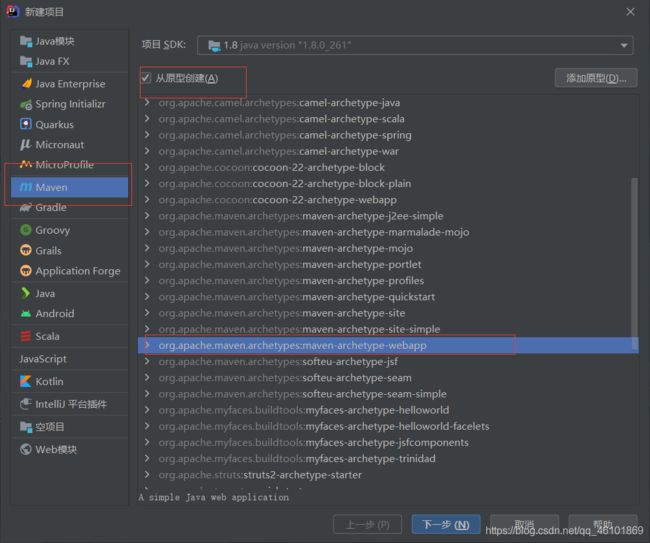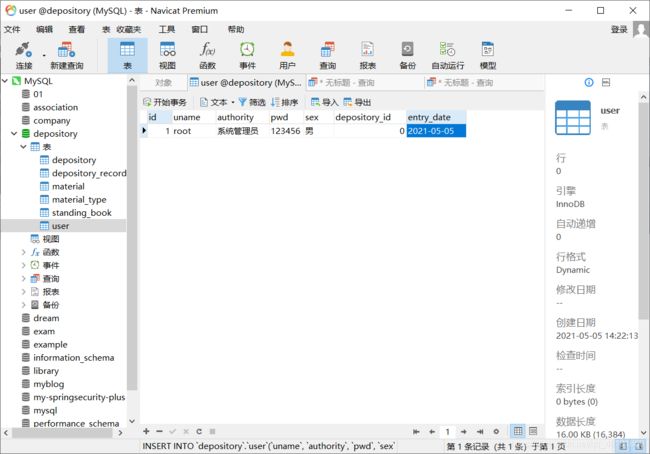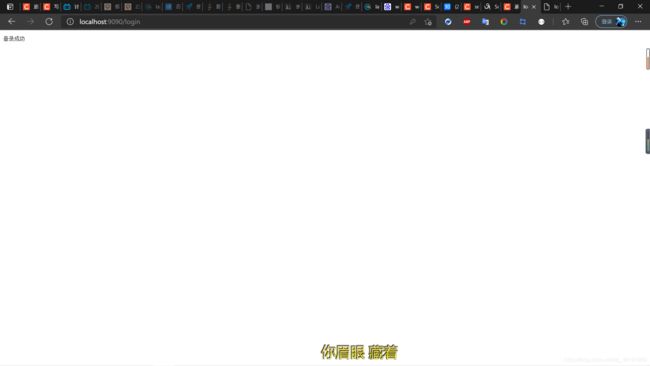手把手教你用Java实现一套简单的鉴权服务(SpringBoot,SSM)(未完待续...)
文章目录
- 前言
- 一、何为鉴权服务
- 二、利用servlet+jdbc实现简单的用户登录程序
-
- 1.明确思路
- 2.手把手教你实现一个简单的web登录程序
-
- ①创建web项目
- ②编写简单的登录页面
- ③编写servlet程序
- ④封装jdbc操作,编写简单的数据库连接池
- ⑤操作数据库
- ⑥配置web.xml
- ⑦idea运行配置
- ⑧运行程序
- 三、回顾改善
-
- 1.密码加密裸奔
- 2.登录信息未存储
- 3.未完待续...
- 四、用SpringBoot+SSM实现一套简单的鉴权服务(注册,登录,权限控制)
前言
时遇JavaEE作业,题目要求写个简单web登录程序,按照老师的意思是用servlet、jsp和jdbc完成。本着要么不做,要做就要做好的原则,我开始着手完成此次作业(其实也是写实训作业的用户鉴权部分),而之前写项目的时候也有相关经验,这次正好能派上用场。
一、何为鉴权服务
引用百度百科的话说
鉴权(authentication)是指验证用户是否拥有访问系统的权利。
鉴权包括两个方面:
- 用户鉴权,网络对用户进行鉴权,防止非法用户占用网络资源。
- 网络鉴权,用户对网络进行鉴权,防止用户接入了非法的网络,被骗取关键信息。
而我们这里的鉴权主要指用户鉴权,即如何确认“你是你”。最简单的体现便是平常用的用户登录登出。
现今大部分系统都会有自己的鉴权服务,它是用户与系统交互的第一步,系统需要一系列步骤明白你是谁,你可以做哪些事,明白了这些之后它才能更好的服务于你。
二、利用servlet+jdbc实现简单的用户登录程序
1.明确思路
首先,我们要仔细思考一下我们到底需要什么?
先让我们回想一下一般的登录是如何做的呢?
对于网页,首先会出现一个登录页面,然后呢,输入账号密码,点击登录,就会弹出成功/失败的页面。
那如何去判断成功/失败呢?
思考一下,最简单的方法便是拿到前端传来的数据之后便将其拿到数据中去查,看看密码是不是一样,然后给前端回复说——我找到了,他就是XXX或者我找不到他的记录,让他重新输入账号密码。
然后前端对此回复做出相应的操作,比如登录成功便跳转到首页,失败让用户重新输入。
2.手把手教你实现一个简单的web登录程序
出于某些原因,我这里手把手教你如何实现一个简单的web登录程序。
①创建web项目
打开idea,新建一个web项目
这里为了方便jar包的管理,选择maven结构的项目(至于什么是maven结构,不懂的可以百度,了解概念即可),然后选择从原型创建,选择webapp(这里只是方便,你也可以选择空项目,不过会费点时间)。
点击下一步,输入项目名称
这里选择相应的maven,idea里有自带的maven和jar包仓库,不过我是自己去官网下了一个(不下也完全可以)。
选择完成,这样一个最简单的项目结构就出来了。
接下来需要配置一下pom.xml,因为要用到jdbc和tomcat的jar包(毕竟都是调用人家的接口(笑哭))
<dependencies>
<dependency>
<groupId>org.apache.tomcat.embedgroupId>
<artifactId>tomcat-embed-coreartifactId>
<version>9.0.37version>
dependency>
<dependency>
<groupId>mysqlgroupId>
<artifactId>mysql-connector-javaartifactId>
<version>8.0.20version>
dependency>
dependencies>
(加在project标签里就行),上面配置的意思就是导入两个第三方工具包
②编写简单的登录页面
这里我既想要好看,又想偷懒,所以用了layui框架的模板
<html>
<head>
<meta charset="UTF-8">
<title>后台管理-登陆title>
<meta http-equiv="X-UA-Compatible" content="IE=edge,chrome=1">
<meta http-equiv="Access-Control-Allow-Origin" content="*">
<meta name="viewport" content="width=device-width, initial-scale=1, maximum-scale=1">
<meta name="apple-mobile-web-app-status-bar-style" content="black">
<meta name="apple-mobile-web-app-capable" content="yes">
<meta name="format-detection" content="telephone=no">
<link rel="stylesheet" href="../lib/layui-v2.6.3/css/layui.css" media="all">
<style>
.main-body {
top:50%;left:50%;position:absolute;-webkit-transform:translate(-50%,-50%);-moz-transform:translate(-50%,-50%);-ms-transform:translate(-50%,-50%);-o-transform:translate(-50%,-50%);transform:translate(-50%,-50%);overflow:hidden;}
.login-main .login-bottom .center .item input {
display:inline-block;width:227px;height:22px;padding:0;position:absolute;border:0;outline:0;font-size:14px;letter-spacing:0;}
.login-main .login-bottom .center .item .icon-1 {
background:url(../images/icon-login.png) no-repeat 1px 0;}
.login-main .login-bottom .center .item .icon-2 {
background:url(../images/icon-login.png) no-repeat -54px 0;}
.login-main .login-bottom .center .item .icon-3 {
background:url(../images/icon-login.png) no-repeat -106px 0;}
.login-main .login-bottom .center .item .icon-4 {
background:url(../images/icon-login.png) no-repeat 0 -43px;position:absolute;right:-10px;cursor:pointer;}
.login-main .login-bottom .center .item .icon-5 {
background:url(../images/icon-login.png) no-repeat -55px -43px;}
.login-main .login-bottom .center .item .icon-6 {
background:url(../images/icon-login.png) no-repeat 0 -93px;position:absolute;right:-10px;margin-top:8px;cursor:pointer;}
.login-main .login-bottom .tip .icon-nocheck {
display:inline-block;width:10px;height:10px;border-radius:2px;border:solid 1px #9abcda;position:relative;top:2px;margin:1px 8px 1px 1px;cursor:pointer;}
.login-main .login-bottom .tip .icon-check {
margin:0 7px 0 0;width:14px;height:14px;border:none;background:url(../images/icon-login.png) no-repeat -111px -48px;}
.login-main .login-bottom .center .item .icon {
display:inline-block;width:33px;height:22px;}
.login-main .login-bottom .center .item {
width:288px;height:35px;border-bottom:1px solid #dae1e6;margin-bottom:35px;}
.login-main {
width:428px;position:relative;float:left;}
.login-main .login-top {
height:117px;background-color:#148be4;border-radius:12px 12px 0 0;font-family:SourceHanSansCN-Regular;font-size:30px;font-weight:400;font-stretch:normal;letter-spacing:0;color:#fff;line-height:117px;text-align:center;overflow:hidden;-webkit-transform:rotate(0);-moz-transform:rotate(0);-ms-transform:rotate(0);-o-transform:rotate(0);transform:rotate(0);}
.login-main .login-top .bg1 {
display:inline-block;width:74px;height:74px;background:#fff;opacity:.1;border-radius:0 74px 0 0;position:absolute;left:0;top:43px;}
.login-main .login-top .bg2 {
display:inline-block;width:94px;height:94px;background:#fff;opacity:.1;border-radius:50%;position:absolute;right:-16px;top:-16px;}
.login-main .login-bottom {
width:428px;background:#fff;border-radius:0 0 12px 12px;padding-bottom:53px;}
.login-main .login-bottom .center {
width:288px;margin:0 auto;padding-top:40px;padding-bottom:15px;position:relative;}
.login-main .login-bottom .tip {
clear:both;height:16px;line-height:16px;width:288px;margin:0 auto;}
body {
background:url(../images/loginbg.png) 0% 0% / cover no-repeat;position:static;font-size:12px;}
input::-webkit-input-placeholder {
color:#a6aebf;}
input::-moz-placeholder {
/* Mozilla Firefox 19+ */ color:#a6aebf;}
input:-moz-placeholder {
/* Mozilla Firefox 4 to 18 */ color:#a6aebf;}
input:-ms-input-placeholder {
/* Internet Explorer 10-11 */ color:#a6aebf;}
input:-webkit-autofill {
/* 取消Chrome记住密码的背景颜色 */ -webkit-box-shadow:0 0 0 1000px white inset !important;}
html {
height:100%;}
.login-main .login-bottom .tip {
clear:both;height:16px;line-height:16px;width:288px;margin:0 auto;}
.login-main .login-bottom .tip .login-tip {
font-family:MicrosoftYaHei;font-size:12px;font-weight:400;font-stretch:normal;letter-spacing:0;color:#9abcda;cursor:pointer;}
.login-main .login-bottom .tip .forget-password {
font-stretch:normal;letter-spacing:0;color:#1391ff;text-decoration:none;position:absolute;right:62px;}
.login-main .login-bottom .login-btn {
width:288px;height:40px;background-color:#1E9FFF;border-radius:16px;margin:24px auto 0;text-align:center;line-height:40px;color:#fff;font-size:14px;letter-spacing:0;cursor:pointer;border:none;}
.login-main .login-bottom .center .item .validateImg {
position:absolute;right:1px;cursor:pointer;height:36px;border:1px solid #e6e6e6;}
.footer {
left:0;bottom:0;color:#fff;width:100%;position:absolute;text-align:center;line-height:30px;padding-bottom:10px;text-shadow:#000 0.1em 0.1em 0.1em;font-size:14px;}
.padding-5 {
padding:5px !important;}
.footer a,.footer span {
color:#fff;}
@media screen and (max-width:428px) {
.login-main {
width:360px !important;}
.login-main .login-top {
width:360px !important;}
.login-main .login-bottom {
width:360px !important;}
}
style>
head>
<body>
<div class="main-body">
<div class="login-main">
<div class="login-top">
<span>LayuiMini后台登录span>
<span class="bg1">span>
<span class="bg2">span>
div>
<form class="layui-form login-bottom" action="/login" method="post">
<div class="center">
<div class="item">
<span class="icon icon-2">span>
<input type="text" name="uname" lay-verify="required" placeholder="请输入登录账号" maxlength="24"/>
div>
<div class="item">
<span class="icon icon-3">span>
<input type="password" name="pwd" lay-verify="required" placeholder="请输入密码" maxlength="20">
<span class="bind-password icon icon-4">span>
div>
div>
<div class="tip">
<span class="icon-nocheck">span>
<span class="login-tip">保持登录span>
<a href="javascript:" class="forget-password">忘记密码?a>
div>
<div class="layui-form-item" style="text-align:center; width:100%;height:100%;margin:0px;">
<button class="login-btn" type="submit" lay-submit="" lay-filter="login">立即登录button>
div>
form>
div>
div>
<div class="footer">
©版权所有 2014-2018 叁贰柒工作室<span class="padding-5">|span><a target="_blank" href="http://www.miitbeian.gov.cn">粤ICP备16006642号-2a>
div>
<script src="../lib/layui-v2.6.3/layui.js" charset="utf-8">script>
<script>
//原本想用json的post发送,结果发现后端数据得自己解析,为了降低难度,直接用form表单的post提交,这样后端直接拿数据即可(不然还得解析Json数据)
// layui.use(['form','jquery'], function () {
// var $ = layui.jquery,
// form = layui.form,
// layer = layui.layer;
//
// // 登录过期的时候,跳出ifram框架
// if (top.location != self.location) top.location = self.location;
//
// $('.bind-password').on('click', function () {
// if ($(this).hasClass('icon-5')) {
// $(this).removeClass('icon-5');
// $("input[name='pwd']").attr('type', 'password');
// } else {
// $(this).addClass('icon-5');
// $("input[name='pwd']").attr('type', 'text');
// }
// });
//
// $('.icon-nocheck').on('click', function () {
// if ($(this).hasClass('icon-check')) {
// $(this).removeClass('icon-check');
// } else {
// $(this).addClass('icon-check');
// }
// });
//
// // 进行登录操作
// form.on('submit(login)', function (data) {
// data = data.field;
// if (data.uname == '') {
// layer.msg('用户名不能为空');
// return false;
// }
// if (data.pwd == '') {
// layer.msg('密码不能为空');
// return false;
// }
// $.ajax({
// url:'/login',
// method:'post',
// data:data,
// dataType:'JSON',
// success:function(res){
// if (res.msg==='登录成功'){
// layer.msg('登录成功', function () {
// window.location = '../index.html';
// });
// }else {
// layer.msg("登录失败");
// }
// },
// error:function (data) {
// }
// }) ;
//
//
// return false;
// });
// });
script>
body>
html>
当然以上代码有一部分注释掉了,原因是如果用JSON格式发送post请求,后端的servlet(准确的说是Tomcat的解析)并没有帮我们解析封装这部分数据,所以我们无法直接get到,得自己另外解析数据,当然也有一些第三方的工具包可以帮我们做这些事情(如阿里的fastjson等),这里为了使其更加简单,所以采用表单提交post请求的方式,这样解析的工作就不用我们做了。
效果是这样的:
如果你没学过layui或者对前端不太行,你也可以这样
<head>
<meta charset="UTF-8">
<title>用户登录title>
head>
<body>
<form action="/login" method="post">
用户名:<input type="text" name="uname">
密码:<input type="password" name="pwd">
<input type="submit" value="login">
form>
body>
html>
一样的功能,不过看上去的效果就不怎么好了。
③编写servlet程序
当有了前端的页面,看上去好了很多,但实质校验的程序我们还没有写。
想象一下我们就是后端程序,当前端的数据历经艰险,从错综复杂的网络中到达我们的服务器,然后经过系统分发到相应端口,这时恰在此端口的tomcat程序接受到了HTTP请求并对其封装,经过一系列骚操作后分发到了我们手中,而我们要做的就是拿着这个封装好的请求进行校验操作,然后对返回对象进行相应修改。
而这也是servlet类所需要做的(如果你想更好的理解servlet,可以看看bravo1988的回答),
package com.dreamchaser.loginTest;
import com.dreamchaser.loginTest.mapper.UserMapper;
import javax.servlet.ServletException;
import javax.servlet.ServletOutputStream;
import javax.servlet.http.HttpServlet;
import javax.servlet.http.HttpServletRequest;
import javax.servlet.http.HttpServletResponse;
import java.io.IOException;
public class LoginServlet extends HttpServlet {
static UserMapper userMapper=UserMapper.getUserMapper();
@Override
protected void doPost(HttpServletRequest request, HttpServletResponse response) throws ServletException, IOException {
doGet(request,response);
}
@Override
protected void doGet(HttpServletRequest req, HttpServletResponse resp) throws ServletException, IOException {
String uname=req.getParameter("uname");
String pwd=req.getParameter("pwd");
ServletOutputStream outputStream = resp.getOutputStream();
String result;
if (pwd.equals(userMapper.getPwdByName(uname))){
//响应
result="登录成功";
}else {
result="登录失败";
}
outputStream.write(result.getBytes());
}
}
你可能会疑惑这个UserMapper是什么,别急,后面会介绍。
④封装jdbc操作,编写简单的数据库连接池
在操作数据库之前,最好写个简单的数据库连接池。一个是简化我们的操作,一个是节省开销,提高性能(Connection是个非常耗费资源的对象,频繁的创建和回收将会是一笔巨大的开销)
package com.dreamchaser.loginTest.utils;
import java.sql.Connection;
import java.sql.Driver;
import java.sql.DriverManager;
import java.sql.SQLException;
import java.util.HashMap;
import java.util.Map;
/**
* 一个简单的数据库连接池
*/
public class Pool {
private static Driver driver;
static {
try {
driver = new com.mysql.cj.jdbc.Driver();
DriverManager.registerDriver(driver);
} catch (SQLException throwables) {
throwables.printStackTrace();
}
}
private static Map<Connection,Integer> pool=new HashMap<>();
private static String url="jdbc:mysql://localhost:3306/depository?serverTimezone=Asia/Shanghai";
private static String user="root";
private static String password="jinhaolin";
/**
* 从连接池中获取一个空闲连接,如果没有则创建一个新的连接返回
* synchronized确保并发请求时,数据库连接的正确性
* @return
*/
public synchronized static Connection getConnection(){
for (Map.Entry entry:pool.entrySet()){
if (entry.getValue().equals(1)) {
entry.setValue(0);
return (Connection) entry.getKey();
}
}
Connection connection=null;
try {
connection=DriverManager.getConnection(url,user,password);
pool.put(connection,0);
} catch (SQLException throwables) {
throwables.printStackTrace();
}
return connection;
}
/**
* 释放connection连接对象
* @param connection
*/
public synchronized static void releaseConnection(Connection connection){
pool.put(connection,1);
}
}
当然上述实现非常简陋,并发性能也不是很好,高并发时可能还会发生OOM,不过凑活着用吧(笑哭)。
⑤操作数据库
package com.dreamchaser.loginTest.mapper;
import com.dreamchaser.loginTest.utils.Pool;
import java.sql.*;
/**
* 查询用户的Mapper
*/
public class UserMapper {
static UserMapper userMapper=new UserMapper();
//单例
public static UserMapper getUserMapper(){
return userMapper;
}
private UserMapper(){
}
//默认数据库中用户名唯一
public String getPwdByName(String name){
Connection connection= Pool.getConnection();
try {
PreparedStatement statement=connection.prepareStatement("select pwd from `user` where uname=?");
statement.setString(1,name);
ResultSet rs=statement.executeQuery();
//resultSet初始下标无法访问,要调用next方法后移一位
rs.next();
return rs.getString(1);
} catch (SQLException throwables) {
throwables.printStackTrace();
}
return null;
}
}
这里采用单例的设计模式,保证UserMapper对象只有一个。(非常简陋,实现也不优雅,看着自己的代码,突然感觉框架好方便啊(笑哭))
这里的作用就是根据用户名查询密码。
⑥配置web.xml
虽然写了servlet,但是tomcat并不知道你这个servlet的类在哪啊,所以必须让tomcat知道,配置web.xml的目的就是通知tomcat在哪(更准确的说是servlet容器)的一种方式(当然也可以用注解)。
配置如下:
<web-app>
<display-name>Archetype Created Web Applicationdisplay-name>
<servlet>
<servlet-name>LoginServletservlet-name>
<servlet-class>com.dreamchaser.loginTest.LoginServletservlet-class>
servlet>
<servlet-mapping>
<servlet-name>LoginServletservlet-name>
<url-pattern>/loginurl-pattern>
servlet-mapping>
web-app>
servlet-class里写你这个Servlet类的路径即可。
⑦idea运行配置
idea配置还是比较方便的。
点击编辑配置,
点击+(添加按钮),选择tomcat服务器(选哪个都可以,我选了tomcat本地)

然后选择相应的服务器程序,配置项目访问的端口,就是tomcat在哪个端口运行(注意不要占用已有端口,默认8080,我这里是因为8080被占了,所以用了9090)

这里还得配置一下工件,因为项目要运行一般有两种方式:
- 一种是打成war包放在tomcat的webapps目录下
- 一种是打成jar包直接运行(SpringBoot就是用这种方式,因为它内置tomcat)
这里工件的作用就是打成war包,至于每次运行部署?idea都会帮你搞定!是不是很方便?
这里那个应用程序上下文的作用就是给访问路径加个前缀
![]()
一般直接写成"/"就行了,这样我们要访问login.html,只需访问http://localhost:9090/login.html就行了,是不是很方便?
⑧运行程序
点击运行
访问localhost:9090/login.html(我因为是在login.html外面放了一个pages包,所以路径是http://localhost:9090/pages/login.html)
我现在数据库里只有root这一条数据,试试效果
输入正确的密码
到这里,我们松了一口气,终于完成了简单的登录功能。
三、回顾改善
别急,我们虽然实现了登录这个功能,但是这个实现是在太简陋了,各方各面都没考虑,返回页面也只登录成功,登录失败的提示。
我们回顾一下,仔细想想有哪些问题,






